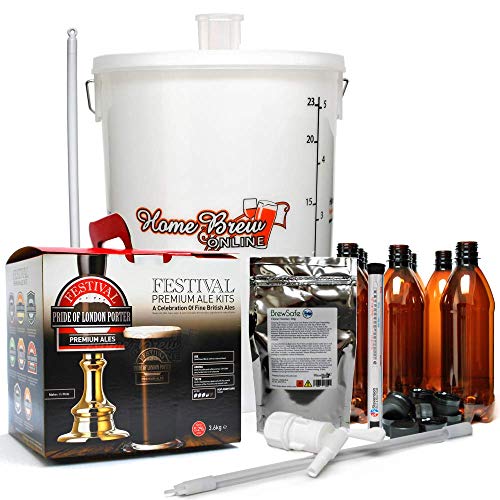
To make up a beer kit you need minimal equipment. The equipment you need is:
- a fermenter (25L food grade bucket), if possible with a tap and transfer tubing;
- a hydrometer;
- a thermometer;
- stirring paddle/spoon;
- kettle
It is advisable to rehydrate yeast, which comes in a dried granular form. You can do this by sprinkling the yeast into a third of a cup of pre-boiled water which has been allowed to cool down to about 30ºC. You can place a plate on top of the rehydrating yeast to enable air borne debris out. The mixture then needs to be left for approximately 30 minutes.
In the mean time, wipe the can/cans with a cloth that has been soaked in a sterilising solution. Place it in a container of boiling water to soften up the contents, thus making it easier to pour.
Let the cans warm through for 5 minutes. Then open with a sanitised can opener. Pour the contents of the can into your fermenter. Rinse the cans with boiling water, adding the boiling water to the fermenter. Then mix well. Ensure that you have oven gloves on as the cans are likely to be hot.
Should you be using DME alongside a one can kit, dissolve your DME in two litres of lukewarm water in a saucepan first. Bring the water to the boil to the DME. Add to the fermenter.
All that is left to do is to top up to the appropriate volume (stated on the kit) using cold water and stir. Stir thoroughly for five minutes, introducing oxygen into the wort. This gives the yeast a great start and helps proper fermentation of your beer.
Firstly it's worth rehydrating the yeast which will come in a dried granular form; this is done by sprinkling the yeast into a third of a cup of lukewarm water.
Once your wort is aerated, check it is below 30ºC. Should the wort be 30ºC plus, snap on the lid. Let it cool down. Place the fermenter in a sink of cold water to speed up the process. Once the yeast is pitched, stir in well and snap on the lid. Slightly open the lid and let it breathe.
Once fermentation has started the beer ought not to be disturbed. Any splashing of the wort can cause oxidation, resulting in an unpleasant flavour. You need to ensure that the temperature in the room ranges between 18-26ºC. Should the temperature be too cold, the yeast can become dormant, Should the temperature become too hot, unpleasant, harsh alcoholic flavours can develop.
Yeast Head
After 3-5 days this yeast head subsides, with fermentation having slowed down. The beer's gravity can be checked. After you have obtained two readings the same in a 24 hour period, you can transfer the beer to a keg or to bottles. You can leave the beer for about 10 days in total, alternatively. You can allow the beer to clear a little, cutting down the sediment in the keg or bottle.
Prior to transferring the beer to a home brew barrel, dissolve 80 grams of brewer's sugar or DME in 100 mls of boiling water. Heat this in a microwave in order to bring back to the boil. Wait a while prior to removing. Take immense care not to disturb the beer as you may end up with a boil over due to uneven heating. You will find that Pyrex jugs are useful for fulfilling this purpose. Add this sugar solution to the home brew barrel prior to transferring the beer. The sugars will ferment in the home brew barrel (or bottle), providing your beer that sparkle. These sugars are called priming sugars.
Transfer the beer as smoothly as you can via transfer tubing attached to the tap or via siphon tubing. The outlet of the tubing ought to be directed to the bottom of the home brew barrel. Upon the liquid level is high enough, the outlet should remain submerged. The fermenter can be slightly tipped to get as much of the wort out as possible. However, the sediment or slurry at the bottom ought to be left behind.
When bottling, try and use a bottling bucket. This is known as a fermenter with a tap fitted with tubing, long enough to reach the bottom of the bottle. Priming sugars are added to the bucket before transferring the beer. This permits for thorough mixing, allowing for bottles to be filled with little disturbance to the beer.
Should you have used home brew barrels or bottles to store the beer, you need to leave them in a warm place for a week to allow them to carbonate or condition. You need to leave them for between two to four weeks to mature. The longer you leave the beer, the better tasting the product will be.
